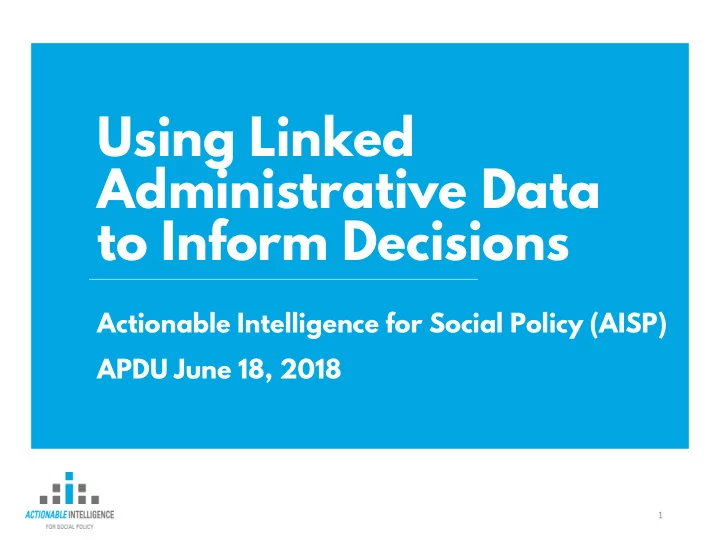

Using Linked Administrative Data to Inform Decisions Actionable Intelligence for Social Policy (AISP) APDU June 18, 2018 1
AISP’S MISSION Buildin Build ing the technic ical l and huma uman capacit ity for for imp improv oved soc ocia ial l policy cy so go gove vernment ca can work better, smarter and faster to se serve communiti ties. s.
OUR PHILOSOPHY Data sh Data shar aring is s as as relati ational al as as it t is s te technical al. We don’t just need We eed to integ egra rate e data, we we need to o integrate peop ople.
WHAT WE DO q Convene a prof profession ional al network ork for local and state governments working on data integration to share best practices and problem-solve together acy on behalf of data sharing at the q Engage in adv advoc ocac federal, state, and local level q Provide free re resourc urces an and d sam ampl ple do docum uments on data governance, legal considerations, data standards, and linkage technologies q Offer a formal train rainin ing an and d technic ical al as assis istan ance program to help interdisciplinary teams build capacity 4
OUR FOCUS IS ON EFFORTS THAT: q Link administrative data across at least three domains/agencies (not just across several programs within an agency) q Serve as a public utility (not research for research’s sake) q Have a clear organizational home & defined governance structure (not one-off projects)
AISP NETWORK 2018 6
Learning Community TA Currently working with 15 sites across 2 cohorts to develop IDS capacity
AISP NETWORK 2020 8
What can IDS do? 9
IDS Help Governments & Research Partners: Support a Master Client Index and Record Reconciliation Across Departments Link Individuals Within a Family Unit or Household Create Longitudinal Cohorts Understand & Address Complex Social Problems 10
Complex Social Problems States are Addressing with IDS: Superutilizers in Healthcare Educational Achievement Gaps The Opioid Crisis Two-Generational Poverty 11
Intervention model testing Intervention model building Descriptive epidemiological study of a social problem Stages of IDS Use
Example: IDS in Action City of Philadelphia Mayor’s Office of Data Management 13
PHASE 1: ANALYSIS Better understand the cumulative impact of early childhood risk factors on children in Philadelphia
Getting the “Right” Data Vital Statistics Public Health Inadequate prenatal Care Lead exposure Low maternal education Teen mother Low birth weight/ preterm birth Homeless Child Welfare Shelter System Shelter stays Child maltreatment School District Academic & Behavioral Outcomes
Unique Influence of Risks on 3 rd Grade Outcomes Top 3 most harmful risks for educational outcomes Reading 1. Low maternal education 2.High lead exposure 3. Child maltreatment Classroom Engagement 1. Child maltreatment 2.Low maternal education 3. Homelessness Truancy 1. Low maternal education 2.Child maltreatment 3. Teen mother Rouse & Fantuzzo (2009); Rouse, Fantuzzo & LeBoeuf (2011); Fantuzzo, LeBoeuf & Rouse (2014)
Cumulative Influence of Risks Wi With ea each addit itio ional l ris isk a a child is… 30% less likely to meet reading proficiency in 3 rd grade. 30-40% less likely to be engaged in the classroom in 3 rd grade. 50-100% more likely to be truant in 3 rd grade. Rouse & Fantuzzo (2009); Rouse, Fantuzzo & LeBoeuf (2011); Fantuzzo, LeBoeuf & Rouse (2014)
Intervention model testing Intervention model building Descriptive epidemiological study of a social problem
PHASE 2: ANALYSIS Map the distribution of early childhood risk factors across the city Compare that distribution to the distribution of publicly-funded high quality early childhood programs
20
IMPACT City was distribute new pre-K seats in high-risk, low-supply neighborhoods 21
Intervention model testing Intervention model building Descriptive epidemiological study of a social problem
PHASE 2: OPERATIONAL DEPLOYMENT • Negotiate separate legal agreements to allow a data pull to flag individual children who qualify as high-risk and live in neighborhoods with new pre-K slots • Encourage case workers or others who may be in routine touch with family to provide referral Important caveat: Workers are not told why a child is flagged as eligible
PHASE 3: ANALYSIS Evaluate the impact of Philadelphia’s pre-K expansion across domains, with a special focus on children with cumulative risk factors (ongoing)
Intervention model testing Intervention model building Descriptive epidemiological study of a social problem
Common Challenges & Opportunities in IDS 26
AISP Expert Panel Reports: Published March, 2017 Challenges to Address: • Scalability, Security, Standardization, Automation, Personnel, Community Engagement, Comparability Emerging Best Practices for: • Legal Issues • Governance • Data Standards • Technology & Security
AISP Network Survey 2018 Wh What do you u consider r to be stre rengths Wh What lingeri ring challenges do you u face of of you our IDS DS? ? as as an an IDS DS? ? Top responses: Top responses: • Impac Im pacting po policy an and d pr program am • Sustai Su ainabl able fundi ding mode del decisions de • Metadata management • Data partner engagement • Enabling access for external researchers • Linking to county & state data • Linking to federal data Wh What policy are reas do you u anticipate wi will be of highest intere rest to yo your IDS DS and local policy-ma makers o over t the n next t three y years? Top responses: • Early childhood ed educati tion • K-12 education • Juvenile justice • Housing & homelessness • Social determinants of health 28
On the Horizon: AISP Field-Building 2018-2020 • Future cohorts of sites building IDS capacity • New cohorts working collaboratively on use cases • Researcher training IRB module • Civic Data Infrastructure Working Group • Communications toolkit 29
Questions? adeliaj@upenn.edu 30
Recommend
More recommend